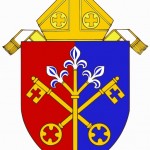So many words have been written about Jahi McMath, the 13-year-old California girl who was declared brain-dead after she suffered complications following a tonsillectomy. Jahi’s parents didn’t believe that and wanted her kept on life support. This week, Jahi has finally been transferred from Children’s Hospital Oakland to a Catholic care facility where she has received a feeding tube and a tracheal tube to replace the ventilator which has kept her alive since December 9.

Today Bishop Robert Finn, bishop of the Diocese of Kansas City-Saint Joseph, weighs in. In a column in the Catholic Key, Bishop Finn talks about his conversation with Dr. Paul A. Byrne, noted expert on brain death, who has attended Jahi at her new facility. Bishop Finn wrote:
What moved me most was something I had not yet read in any media accounts: He told me that Jahi was not totally unresponsive–but rather, when touched or talked to by family members, she moves her arms and/or legs. I must say that this is not what I imagined in the case of someone who is dead.
Indeed, Dr. Byrne noted some other indicators that the teen is, in fact, still alive. I quoted him over on the Kresta in the Afternoon blog:
Dr. Paul Byrne, who examined Jahi while she was still a patient at Children’s Hospital, said at the time that she was alive–despite the hospital’s insistence that Jahi was “brain dead.” In the state of California, loss of brain activity is equated with legal death; but Dr. Byrne reported that her heart was beating on its own, her organs were functioning and she was responding to family members with purposeful movements. He was certain that she was healing from her tonsillectomy–and healing, Dr. Byrne noted, happens only in a living person.
(I also, by the way, offered an explanation of what the Catholic Church teaches about brain-death. You can read a helpful article from the National Catholic Bioethics Center here.)

Children, according to Dr. Byrne, have a higher rate of recoverability from brain injuries. Their brains are more “pliable” and can heal in ways that often surprise the experts. The observation of reactions (movement of arms or legs) like those reported to be seen in Jahi, lends credence to the possibility that, though there are no measurable brain waves, brain activity may still exist and life may still be present.
Bishop Finn’s hope that Jahi McMath might awake and that her family might once again enjoy the blessing of her company is one which we all share. There is no guarantee of that, however. Bishop Finn closes his column with a reminder that we should pray for Jahi and for her family, and pray that science will always base its decisions upon moral principles:
As I write this so much is changing, and by the time you read this so much may have occurred in the life of Jahi and her family. But I still ask you this: Pray for Jahi and for this family. Pray also that authentic moral principles will be upheld in the midst of a scientific endeavor which is always complicated, but which requires many, many prudential decisions. We must work hard and speak out clearly for the protection of human life at all its moments.
Mary, Mother of God, and our Mother, pray for us.
* * * * *
I’ve written before about the near-death experiences of people who experienced serious brain trauma. One is Dr. Eben Alexander, an atheist whose experience of God while comatose led to his conversion; the other is three-year-old Colton Burpo, whose dramatic story will be told in a new movie, Heaven Is for Real, opening in theatres on Easter 2014.











